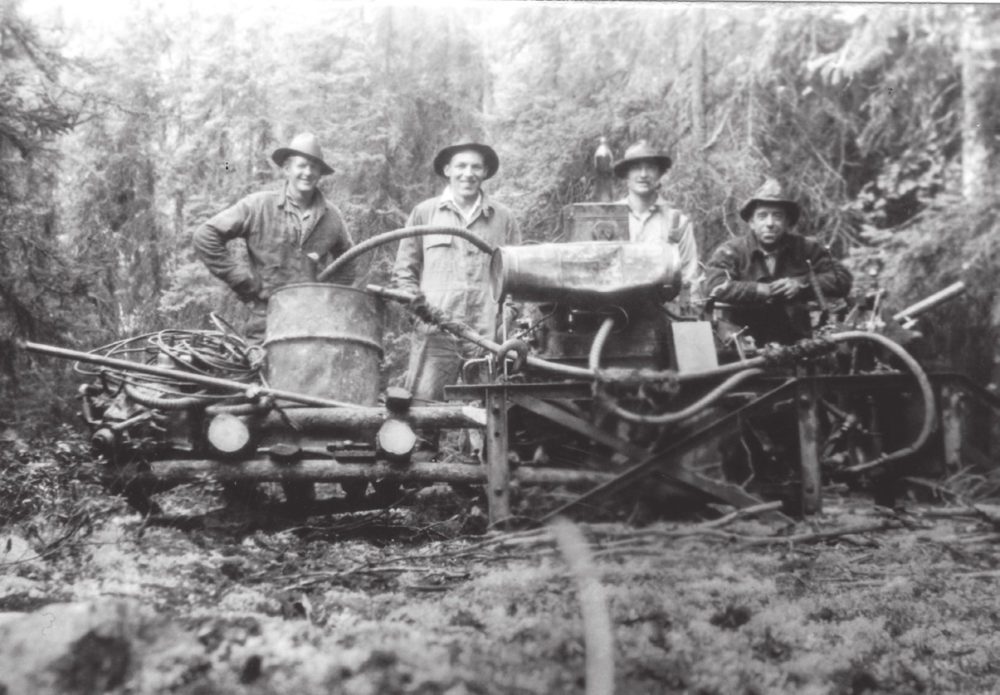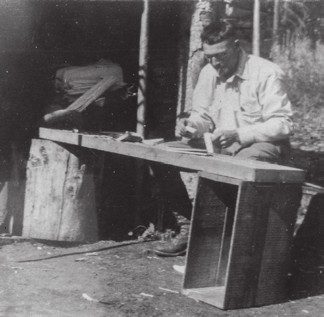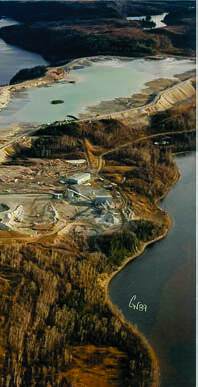
As early as 1898, pioneer prospectors trudged across the Bulkley Valley in west-central British Columbia. This group included William Binnie “Tom” Forrest, who staked the Bulkley Valley’s first mineral claims on Hudson Bay Mountain and Dome Mountain near Smithers. By 1905 to 1907, more prospectors were combing the mountains through the Bulkley Valley, in anticipation of the Grand Trunk Pacific Railway.
William Fleet Robertson, provincial mineralogist, toured the Bulkley Valley on horseback in 1905 to examine and assess the mineral and coal resource potential of the region. By 1908, many new copper discoveries, especially in the Telkwa Range southeast of Smithers, were being reported.
Two early prospectors, H.J. MacDonald and Charles Newman, ventured into Babine Lake in 1900. They initially travelled southeast, where they discovered quartz veins with copper and silver minerals on a small island known locally as Silver Island. They then travelled north, prospecting on the various islands, and eventually discovered copper mineralization on Copper Island, later renamed McDonald Island. The copper showing and several other occurrences were staked collectively as the Richmond property.
The two partners continued prospecting northward along Babine Lake. They discovered and staked a lead-zinc-silver occurrence on the western shore of a peninsula north of Copper Island, appropriately named Newman Peninsula after Charles Newman. Several other veins with considerable zinc mineralization were also discovered. Two of the larger veins on the original discovery were reported to be nine metres and 15 metres wide, respectively. Newman explored these veins by driving 12-metre and 17-metre underground tunnels close to the shore of Babine Lake. A sample from the larger vein assayed 1.05 ounces per ton silver and 4.35 per cent copper.
MacDonald and Newman had lifelong dreams of discovering a big bonanza, which had them returning to Copper Island in the following seasons to further prospect around their earlier discoveries. In addition to surface trenching, they explored the copper showings by driving two underground adits, 17 metres and 24 metres across, in continuous mineralization with abundant malachite and minor chalcopyrite and bornite. Samples from these workings returned 0.75 to 1.4 per cent copper, 0.12 to 0.26 ounces per ton silver and 0.03 ounces per ton gold. An eight-metre prospect shaft was also sunk on an outcrop with copper mineralization; two samples averaged 1.05 per cent copper and 0.22 ounces per ton silver.
These copper showings would, in later years, be further explored and developed to become the Granisle copper mine. In addition to the copper showings, a 10- to 40-centimetre-wide galena vein with promising silver and gold values was discovered at the southwest corner of the island, close to the shore. It was also explored with an 11-metre tunnel.
MacDonald also had high hopes for the original copper-silver discovery on Silver Island. His determination to develop a mine at this property was eventually realized. However, it was never a big producer and was closed when the market crashed in 1929.
In May 1929, the Consolidated Mining and Smelting Company of Canada Limited, which later became Cominco, optioned the Richmond property on McDonald Island, drilling eight diamond drill holes totalling 1,219 metres. A zone of copper mineralization was identified, and a resource of approximately eight million tons grading 0.8 per cent copper, with minor gold and silver, was estimated. Possibly due in part to the economic downturn, exploration was halted the same year, and the property reverted back to MacDonald and Newman.
By 1940, E.T. Campbell and Associates had acquired the Richmond and Newman properties. The company, however, focused on the lead-zinc silver occurrence at the southwest corner of McDonald Island rather than evaluating the copper potential, and the properties remained dormant for several years.
In 1943, Dr. Victor Dolmage was requested to re-examine the potential of McDonald Island – in particular, the drilling completed by the Consolidated Mining and Smelting Company of Canada Limited. However, it was not until 1955 that Dolmage’s favourable report caught the attention of Larry Postle and Keith Fahrni of Granby Mining Company, sparking an immediate decision for followup exploration. Fahrni was especially impressed with the numerous copper showings on the island. Granby drilled eight diamond drill holes, totalling 675 metres, before freeze-up. The crew returned early the following spring to mobilize equipment, supplies and camp to McDonald Island. A major drilling program, consisting of 40 holes, was completed in the summer.
Granisle Copper Limited was established in 1957 as a subsidiary of Granby to co-ordinate the company’s Babine programs. By the end of 1962, drilling had defined the Granisle copper deposit to a depth of 152 metres, and an open pit reserve of 22.7 million tons grading 0.53 per cent copper was evaluated. Based on this, a feasibility study for mine development was completed in 1963, and plans were announced for mine construction and ore production at 5,000 tons per day. Construction of the plant commenced in the summer of 1963, along with preparation for a townsite on the southwest shore of Babine Lake. To ensure year-round barge access, an innovative bubbler system was installed to maintain a 30-metrewide open channel across the lake during the winter season. Production commenced on November 16, 1966.
With the mine operating at capacity and the ore body extended to depth, expansion plans were considered in 1970. However, Granby was facing a corporate takeover by Pacific Holding Corporation of California, which had acquired 51 per cent of Granby’s shares. In 1971, Zapata Norness Inc. purchased Pacific Holding’s ownership of Granby shares and, in 1979, amalgamated Granby and Granisle with Zapata to become Zapata Granby Corp. The takeover marked the end of Granby, one of the longest-standing, most resourceful and most successful companies in the history of British Columbia’s mining industry.
In the midst of the corporate turmoil, a major plant expansion, upgrading it from 6,000 to 14,000 tons per day, was completed in 1972. This included additional housing at the townsite, a new barge landing dock at the mine site and the acquisition of larger equipment. By 1974, Granisle employed approximately 300 workers.

In 1979, Noranda Mines Ltd., which was operating the adjacent Bell copper mine, purchased the Canadian holdings of Zapata Granby. The two mines operated under Noranda until 1982, when production stopped due to low copper prices.
The small lead-zinc-silver veins that MacDonald and Newman discovered in the early 1900s were about 800 metres west of the Bell copper deposit. In 1945, bulldozer trenching exposed a pyrite-bearing porphyry rock unit. Seventeen years later, the notation of this exposure caught the attention of Dr. Archie Bell of Noranda as being possibly favourable for copper mineralization. Claims were quickly staked across the peninsula.
Noranda immediately commenced exploration on the newly staked claims and the surrounding area. Co ordinated by Dave Lowrie and Gavin E. Dirom, initial exploration involved geological mapping and soil sampling around the old lead-zinc showings, and stream sediment sampling of drainages on and around Newman Peninsula. Fortuitously, when one of the field crews could not be mobilized due to a helicopter breakdown, the stranded crew decided to conduct a preliminary electromagnetic test survey, extending across the peninsula from the lead-zinc showings and an adjacent rusty bluff. Strong anomalous readings were immediately recorded; it was later determined that they represented the pyrite halo bounding the yet-to-be-discovered Newman copper deposit.
With this encouragement, additional soil sampling in early 1963 defined a prominent copper anomaly. Three diamond drill holes were drilled to explore the geochemical and electromagnetic anomalies. A fourth hole, drilled at the start of the 1964 drill program, intersected 58 metres grading 0.94 per cent copper. These four holes were the discovery holes for the Newman copper deposit, later renamed the Bell copper deposit.
Followup drilling from 1964 through 1968 defined this new deposit to a depth of 244 metres, and a mineral resource of 128 million tons grading 0.48 per cent copper was estimated. Based on this, a feasibility study to develop the Newman deposit commenced in 1969, and a mineable ore reserve of 46 million tons grading 0.5 per cent copper was evaluated. Construction of the 10,000-ton-per-day open-pit mine started in 1971, pre-production mining operations commenced in February 1972, and the first ore was delivered to the concentrator in October 1972.

Location of Bell
and Granisle mines
Location of Bell
and Granisle mines
New housing was constructed at Granisle. As before, a bubbler system was installed across Babine Lake to ensure year-round access to the mine site. In recognition of this exciting discovery and the successful development of the mine, Noranda established its Bell Copper Division as a tribute to Dr. Bell and the exploration crews.

Concurrent with the exploration work at the Bell copper deposit, Noranda was actively co-ordinating a regional exploration program on and around the Newman Peninsula. This included stream sediment sampling from creeks draining into Morrison Lake north of the deposit. Two of the samples were highly anomalous in copper, and the followup examination at the beginning of the 1963 field season discovered copper mineralization in float and exposures along a small creek bed near the southeastern end of the lake. This was the discovery of the Morrison copper deposit.
For Noranda’s field crews, 1963 was a banner year, as they discovered two major copper projects in one camp. Seven diamond drill holes were drilled in 1963, and by 1973 subsequent drilling had delineated the Morrison deposit. Considerable exploration and advanced evaluation studies have been undertaken since 1973 by a junior exploration company, but the project has not yet been developed.

The discovery of the Bell and Morrison porphyry copper-gold deposits in 1963 and mine construction at Granisle in 1965 attracted many mining and exploration companies to the Babine Lake area. Using geochemical and geophysical techniques, a number of new discoveries were made. One of the most intriguing discoveries was made by Tro Buttle Exploration in 1967, with the uncovering of spectacular chalcopyrite-filled breccia mineralization in a bulldozer trench on Hearne Hill. A large slab of this flashy mineralization was displayed in Smithers, creating immediate excitement for the exploration companies.
This discovery was located only about 1.5 kilometres southeast of the Morrison deposit. Texas Gulf Sulphur Company optioned the property and proceeded to identify a large, low-grade porphyry copper system, within which a comparatively restricted high grade copper breccia pipe was defined.

The property was subsequently explored by several other companies that identified a second high-grade breccia pipe. Due to the rather small size of these breccia pipes, the property is still undeveloped. Additionally, a number of other discoveries in the Babine camp were tested by diamond drilling and limited percussion drilling. Properties such as Nak, Dorothy, Old Fort and Trail Peak were explored quite extensively but have not been advanced.
The closure of the Bell and Granisle mines in October 1982 due to low copper prices was devastating for workers at the mines. The population of Granisle decreased from more than 1,500 to under 500. Economic studies were undertaken to determine if the Bell mine could be reopened, but the bleak forecast for copper prices dampened these plans. (The Bell mine did subsequently operate once more from 1985 to 1992). There are, however, optimistic visions that the Morrison project might be developed in the near future.


